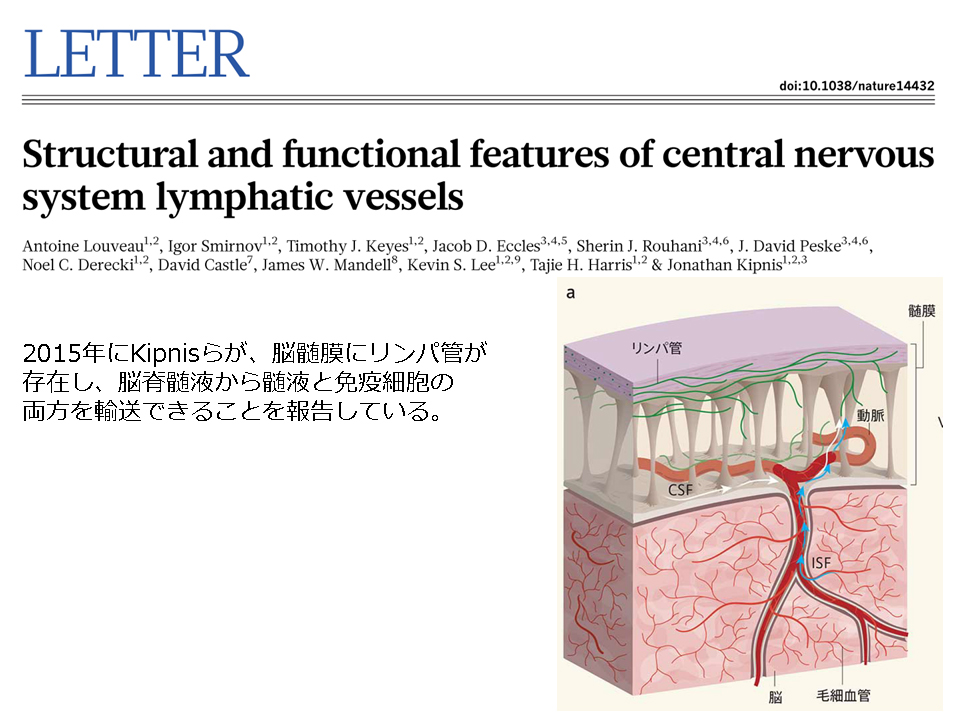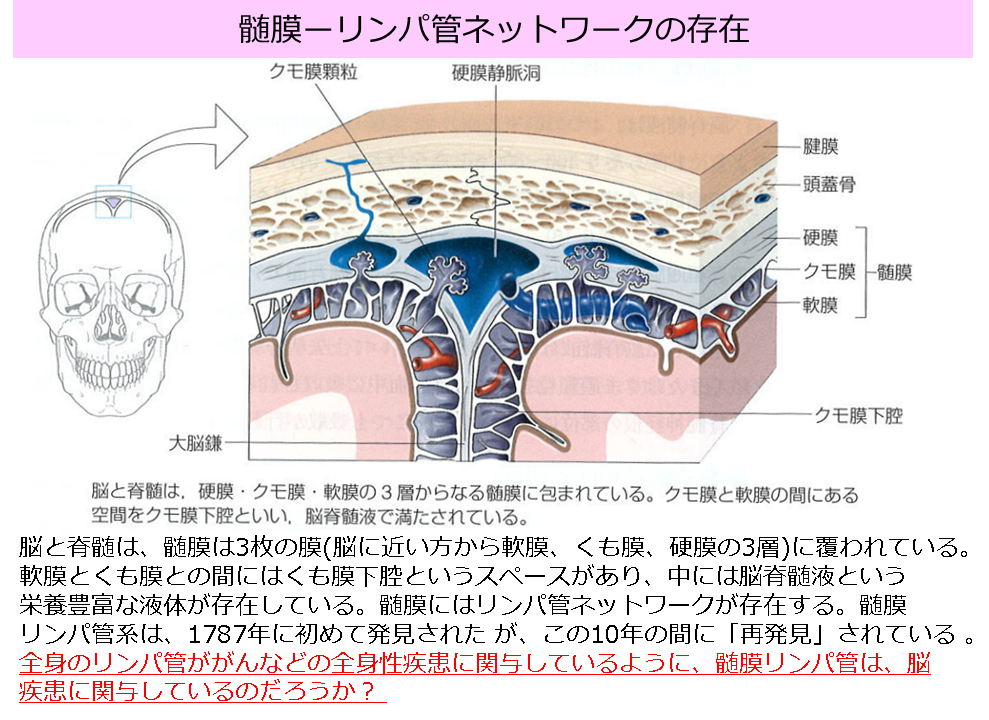Functional aspects of meningeal
本日のラボセミナーでは、研究生として来日した学生(大学院人間総合科学研究科 感性認知脳科学専攻 研究生)の自己紹介の後、ジャーナルクラブと筑波会議のショートプレゼンテーションの練習を行いました。
アルツハイマー病:加齢とアルツハイマー病における髄膜リンパ管の機能的側面
Sandro Da Mesquita, Antoine Louveau, Andrea Vaccari, Igor Smirnov, R. Chase Cornelison, Kathryn M. Kingsmore, Christian Contarino, Suna Onengut-Gumuscu, Emily Farber, Daniel Raper, Kenneth E. Viar, Romie D. Powell, Wendy Baker, Nisha Dabhi, Robin Bai, Rui Cao, Song Hu, Stephen S. Rich, Jennifer M. Munson, M. Beatriz Lopes, Christopher C. Overall, Scott T. Acton & Jonathan Kipnis
Abstract
Ageing is a major risk factor for many neurological pathologies, but its mechanisms remain unclear. Unlike other tissues, the parenchyma of the central nervous system (CNS) lacks lymphatic vasculature and waste products are removed partly through a paravascular route. (Re)discovery and characterization of meningeal lymphatic vessels has prompted an assessment of their role in waste clearance from the CNS. Here we show that meningeal lymphatic vessels drain macromolecules from the CNS (cerebrospinal and interstitial fluids) into the cervical lymph nodes in mice. Impairment of meningeal lymphatic function slows paravascular influx of macromolecules into the brain and efflux of macromolecules from the interstitial fluid, and induces cognitive impairment in mice. Treatment of aged mice with vascular endothelial growth factor C enhances meningeal lymphatic drainage of macromolecules from the cerebrospinal fluid, improving brain perfusion and learning and memory performance. Disruption of meningeal lymphatic vessels in transgenic mouse models of Alzheimer’s disease promotes amyloid-β deposition in the meninges, which resembles human meningeal pathology, and aggravates parenchymal amyloid-β accumulation. Meningeal lymphatic dysfunction may be an aggravating factor in Alzheimer’s disease pathology and in age-associated cognitive decline. Thus, augmentation of meningeal lymphatic function might be a promising therapeutic target for preventing or delaying age-associated neurological diseases.
Jonathan Kipnisのラボ https://med.virginia.edu/neuroscience/research/research/kipnis-lab/ から昨年Nature誌に掲載された論文。 2015年にKipnisらが、脳髄膜にリンパ管が存在し、脳脊髄液から髄液と免疫細胞の 両⽅を輸送できることを報告している (Louveau et al., 2015. Structural and functional features of central nervous system lymphatic vessels. Nature. 2015 Jul 16;523
オリジナル論文:https://www.nature.com/articles/s41586-018-0368-8
Nature Digestの日本語解説記事 https://www.natureasia.com/ja-jp/ndigest/v15/n11/%E3%83%AA%E3%83%B3%E3%83%91%E7%AE%A1%E3%81%AB%E3%82%88%E3%82%8B%E8%84%B3%E5%86%85%E3%81%AE%E8%80%81%E5%BB%83%E7%89%A9%E9%99%A4%E5%8E%BB/94712
*身体を構成する細胞のなかで行われている物質代謝の目的は、タンパク質をつくり、エネルギーを取り出すことにある。細胞は毎日、そのために呼吸し、栄養素を分解している。
*ところが、こうした作業にはゴミがつきものである。モノを燃やせば灰になるが、体内でこれと同じ現象が起こると、水と二酸化炭素、そしていくつかの代謝産物ができる。これらは、いわば燃えカスである。燃えカスは、人間社会のゴミと同じように、できるだけ早く処理しなければならない。
*私たちの身体には、個々の細胞から出た燃えカスを回収し、その種類に応じて適切なゴミ処理場まで運び、体外に排出してくれる仕組み(腎臓・肺・皮膚・毛など)が備わっている。
*リンパ系は、老廃物の回収に関わるシステムである。組織内の圧力が高まると、重なり合った内皮細胞の隙間から間質液(interstitial fruid; ISF)がリンパ管に入り込む。間質液には、細胞残屑や毒性分子などの老廃物が含まれているほか、タンパク質も多量に含まれている。
*脳にはリンパ管がないが、髄膜にリンパ管が存在してる。 髄膜内のリンパ管は、齧⻭類、⾮ヒト霊⻑類、およびヒトで⾒つかっている。
*脳循環は、血流が多いのが最大の特徴である。成人の脳重量は体重の約2%にすぎないが、血流量は心拍出量の15%である。脳の酸素消費量は、全身のそれ(安静時約250ml/分)の約20%を占めている。脳では代謝が活発に行われているが、生じた老廃物はどのようにして排出されるのだろうか?
*Xie et al., 2013 “Sleep




“本日のJournal Club (September 30, 2019)” への1件のフィードバック